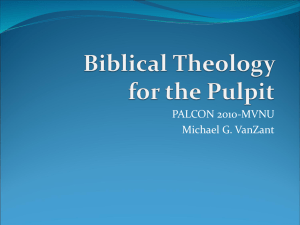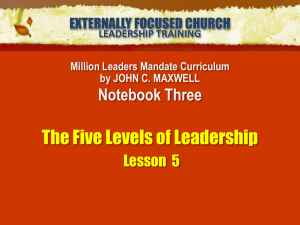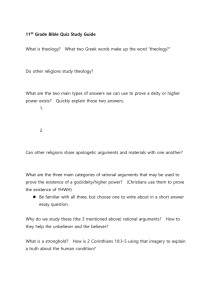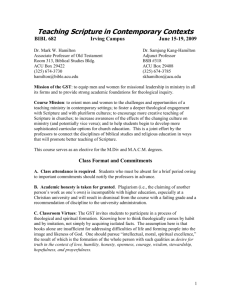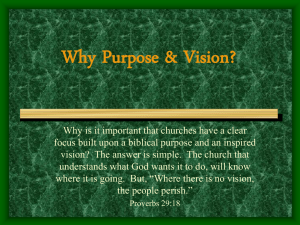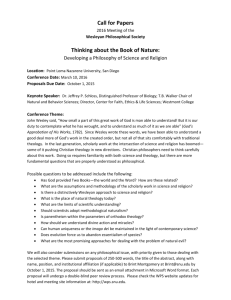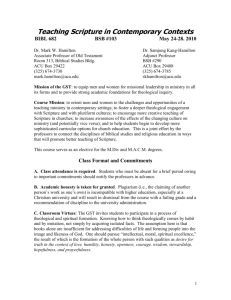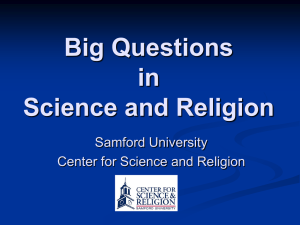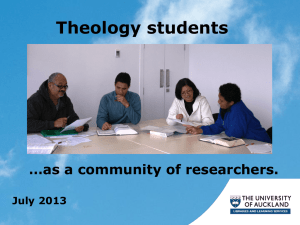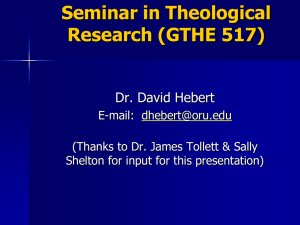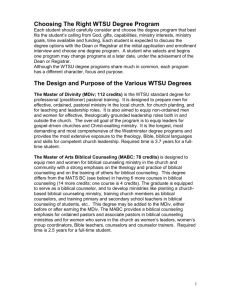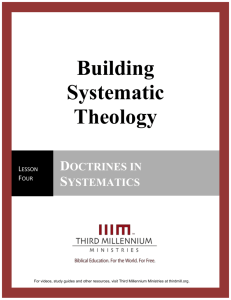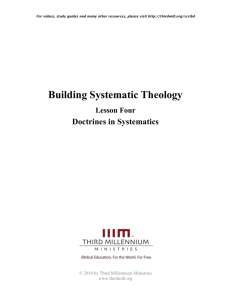Essay on Systematic theology
advertisement
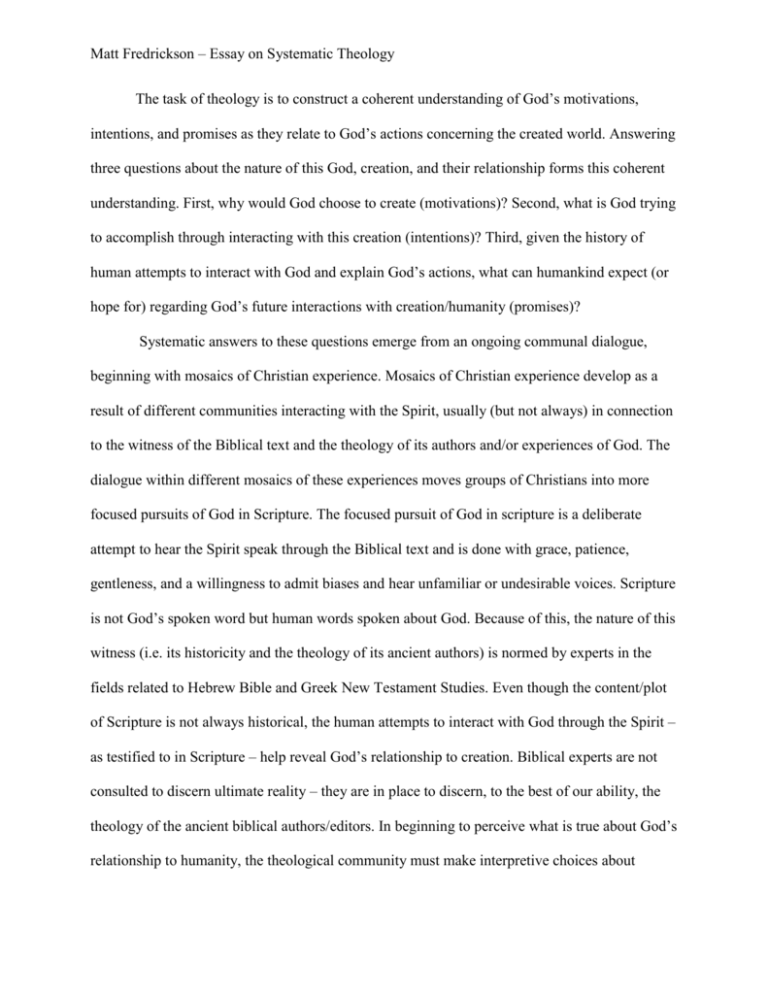
Matt Fredrickson – Essay on Systematic Theology The task of theology is to construct a coherent understanding of God’s motivations, intentions, and promises as they relate to God’s actions concerning the created world. Answering three questions about the nature of this God, creation, and their relationship forms this coherent understanding. First, why would God choose to create (motivations)? Second, what is God trying to accomplish through interacting with this creation (intentions)? Third, given the history of human attempts to interact with God and explain God’s actions, what can humankind expect (or hope for) regarding God’s future interactions with creation/humanity (promises)? Systematic answers to these questions emerge from an ongoing communal dialogue, beginning with mosaics of Christian experience. Mosaics of Christian experience develop as a result of different communities interacting with the Spirit, usually (but not always) in connection to the witness of the Biblical text and the theology of its authors and/or experiences of God. The dialogue within different mosaics of these experiences moves groups of Christians into more focused pursuits of God in Scripture. The focused pursuit of God in scripture is a deliberate attempt to hear the Spirit speak through the Biblical text and is done with grace, patience, gentleness, and a willingness to admit biases and hear unfamiliar or undesirable voices. Scripture is not God’s spoken word but human words spoken about God. Because of this, the nature of this witness (i.e. its historicity and the theology of its ancient authors) is normed by experts in the fields related to Hebrew Bible and Greek New Testament Studies. Even though the content/plot of Scripture is not always historical, the human attempts to interact with God through the Spirit – as testified to in Scripture – help reveal God’s relationship to creation. Biblical experts are not consulted to discern ultimate reality – they are in place to discern, to the best of our ability, the theology of the ancient biblical authors/editors. In beginning to perceive what is true about God’s relationship to humanity, the theological community must make interpretive choices about Matt Fredrickson – Essay on Systematic Theology Scripture in conversation with these biblical experts, the Holy Spirit, and the text itself. This three-way dialogue, born out of experience, is brought into conversation with tradition. Tradition is the history of interpretation of God’s relationship to humanity, located among God’s people everywhere. The working conclusions of these discussions are articulated, enacted (if possible), and evaluated through reasoned contextual experience. That is, their application is tested against the experience and fruitfulness of Christian life within the mosaics of experience that spawned them, so the process can be repeated. This reasoned experiential critique does not necessarily norm claims, but helps improve and situate them based on cultural and experiential context.i This dialogue is normed by the Trinitarian nature of God as both Creator and Consummator and is therefore grounded in the communities of God’s people trying to make sense of their present experience and future hope of the creation being in right relationship to God. In the community’s dialogue, their sources (within the categories/framework I have proposed) are prioritized in an effort to answer the three questions. As an illustration, I will use the above method to give one very brief attempt at providing some possible answers to the three questions. In my experience as a student in the Graduate School of Theology, I took courses that allowed me to study the Hebrew Bible in the Christian community of my peers and professors. These experiences have moved me into a more focused pursuit of God in scripture in the texts of Gen 1-12 and Ps 8 (among others). To the best of my ability, in my community within the GST, I have delved into these texts, attempting to hear the Spirit speak through them via prayerful consideration, open and honest dialogue, and the admission of biases - while at the same time engaging the biblical experts. One bias that circulates within my GST community is the notion that God is on a mission. In my attempts within the community to hear the spirit speak through Matt Fredrickson – Essay on Systematic Theology scripture, it seems plausible that Gen 1-12 points to a God that is interested in the Creation and its future. Indeed, the creation narratives and primordial history (Gen 1-11), followed by the calling of Abraham (Gen 12) and God’s promise that all nations will be blessed because of him, may suggest a God who is engaged in the life of creation, as God makes provisions for preservation and blessing. Through my dialogue in the community, I have continued to construct answers to the three questions in conversation with biblical scholars. While the relationship between God’s possible mission and God’s people in Gen 1-12 is not explicit and the exact nature of Abraham’s role in God’s blessing directed toward all the families of the earth is not clear, biblical scholars can assist in clarifying the nature of God’s supposed partnership with humanity, according to the biblical authors, by identifying a relationship between Gen 1, Ps 8, and the Near Eastern concept of the “image of God.” In Egypt and Mesopotamia the “image of God” referred to the deity’s appointed king.ii This god-king relationship granted god-like power to the human representative. This type of relationship is mirrored in Psalms 2 and 110, in which God gives power to the king to rule with YHWH’s authority. The broader application of the image of God at creation in Gen 1:26-27 is a development called the “democratization of kingship,” in which the power of the king is dispersed throughout the kingdom.iii Therefore, Ps 8, by echoing Gen 1:26-27 evokes not only dominion over animals, but also the authority to rule in creation as God’s chosen representatives. This dialogue with the text via the Spirit and biblical scholars must now interact with tradition. In doing so, the proposals are measured, adjusted, modified, strengthened, or rejected in light of supporting and opposing theological traditions and ideologies. One support, for example, is the concept of the passio dei, in which God’s initiative to create something rather than nothing provisioned within God’s self a desire to accommodate the universe, the earth, and Matt Fredrickson – Essay on Systematic Theology its inhabitants.iv This adds to the idea that God made a decision to engage with a created order – to initiate a course of action that is described in the biblical narrative and portrays a God who interacts with creation. As this discussion takes place, the working conclusions must be articulated, evaluated and/or enacted within their context. For example, if in my communal dialogue with tradition, I combined certain ideas with those of liberation theologians, trying to “rule with YHWH’s authority,” may lead me to take abrasive actions within my community. v The validity of my actions and their supporting claims would be tested and evaluated against the mosaic of Christian the experience and fruitfulness of life and faith within my GST community and subjected to reason. Several options exist, for example: 1) The original claim made in the attempt to listen to the Spirit speak through scripture, in tension with biblical experts is wrong; 2) The original claim was correct, but requires further modification in the realm of tradition; 3) The theological reflection was mostly correct, but the ideology was misapplied within the Christian mosaic of experience. Afterwards, the process is repeated and/or held in conversation with the theological dialogue of other communities (see endnote i). i If a more universal understanding of theology is desired, this discussion can now be held in conversation with the theologizing of communities that have different mosaics of experience. ii John Levenson, Creation and the persistence of Evil: The Jewish Drama of Divine Omnipotence (New York: Harper Collins, 1988), 114. iii Richard J. Middleton, The Liberating Image: The Imago Dei in Genesis 1 (Grand Rapids: Brazos Press, 2005), 204-218. iv Jannie Swart et al., “Toward a Missional Theology of Participation: Ecumenical Reflections on Contributions to Trinity, Mission and Church,” Missiology 37 (2009): 75-87, esp. 84. v Richard J. Middleton, “Created in the image of a violent God? The Ethical Problem of the Conquest of Chaos in Biblical Creation texts,” Interpretation 58 (2004). Here, Middleton cautions against linking the imago dei with types of liberation theology founded in YHWH’s fight against Chaos.
